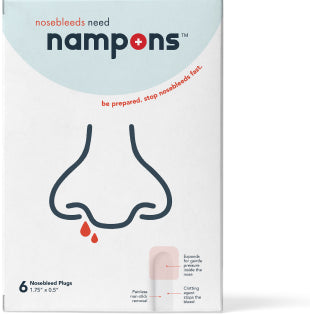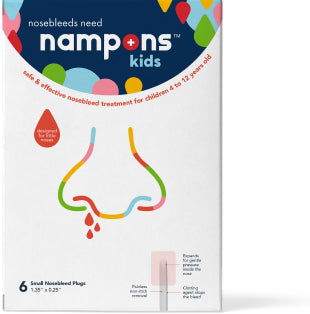This article was written by Dr. RP Lindeman, who received a BA from Yale and an MD-PhD from Columbia. He was trained in general pediatrics and pediatric pulmonary medicine at Boston Children’s Hospital. He practiced pediatrics in Massachusetts for over 20 years.
I am a pediatrician, but I'm also a father. My first son was not born until I had finished my residency and was about to complete my fellowship in pediatric respiratory diseases (the nose is the gateway to the respiratory system, by the way). When I was in residency, my colleagues would worry when their children would get sick much more than they would about their patients. Why? Because (as I would learn soon after) it's different when it's your kid.
What's different when it's your kid?
In the emergency room, I would meet children with nosebleeds that the parents could not stop despite their best efforts. The child's shirt might have been soaked with blood, as would the handfuls of tissues he brought. My heart rate would barely budge as I took a history, performed a physical examination, made a plan, and treated the child.
When my own boys would get nosebleeds, it was another story. It seemed to me that both boys had a massive number of nosebleeds. I mean, it just didn't seem normal. Why did I think this? Because it's different when it's your kid.
My point in telling this story is that it's normal, even for a pediatrician, to worry about nosebleeds. How much more so is it normal for a non-pediatrician to worry, even to panic, when their child's nose bleeds! My children were born during the dawn of the internet age (for some context, we all called it the 'worldwide web' or just 'the web').
Googling was not a thing back then, and finding medical information was much more complicated than it is today. This was a blessing in a way. Today, parents can discover all kinds of frightening details in seconds while trying to stanch the flow of a nosebleed. With one hand, they're applying pressure to the bridge of their child's nose, and with the other, they're typing, 'What could my child's nosebleed mean'? I'll need to teach a quick anatomy lesson to answer this question.
A quick guide to the nose
The nose is an intricate organ that plays a vital role in our respiratory system and sense of smell. It's made up of both bone and cartilage. The outside part of the nose includes the nasal bridge, nostrils, and tip. Internally, the nose is divided into two cavities separated by a septum (you may have heard of a 'deviated septum'; that's what this is).
The nasal cavities are lined with a specialized mucous membrane that helps filter, warm, and humidify our air. This membrane is rich in blood vessels and exceptionally tiny capillaries near the surface. These delicate blood vessels supply oxygen and nutrients to the nasal tissues. However, they can also be prone to bleeding if irritated or damaged. Understanding the complex anatomy of the nose can provide insight into why nosebleeds occur and help us take appropriate steps to prevent and manage them effectively. Now we can get to what your child's nosebleed could mean.
Common causes of nosebleeds
I began this post by mentioning that I'm a father and a pediatrician. I did this for a reason. Pediatricians know too much. My mind immediately races to the worst possible diagnosis, even though it might be at the bottom of the list of possibilities. I mentioned the internet because parents can quickly find the most severe interpretation of a nosebleed today. For this reason, I will address the metaphorical 'elephant in the corner'.
It is improbable that your child's blood has suddenly lost the ability to clot. Yes, some serious diseases involving the bone marrow will have this effect. I stress that they are extremely unlikely.
We have a saying in medicine: 'If you hear hoofbeats behind you, think horses; don't think zebras'. The adage means that common things happen commonly, and uncommon things happen uncommonly. Zebras are rare, especially in this part of the world. The overwhelming majority of childhood nosebleeds happen for the following reasons.
Dry air
I live on Cape Cod, Massachusetts, where the driest day of the year is still humid. However, especially during the winter, heating systems dry out the air so much that dry air is among the most common causes of nosebleeds in children. Dry air can irritate the nasal passages and lead to nasal dryness and crust formation, making the blood vessels more prone to bleeding. Using a humidifier in your child's room can help alleviate this issue.
Nose picking
Children often explore their bodies. This exploration is normal, and I'm inclined to say even healthy. However, nose picking can cause minor injuries to the blood vessels, resulting in a nosebleed. Once these blood vessels break and begin to heal, they remain temporarily vulnerable to rebleeding. Even a cough or a sneeze can cause a nosebleed to recur. Remain calm and gently remind the child not to touch their nose.
Nasal allergies and colds
Allergies and colds can cause inflammation and congestion in the nasal passages. Inflammation is nothing more than swelling, including swelling of those tiny blood vessels that become fragile when swollen. The constant nose blowing and excessive rubbing can irritate the nasal lining and lead to nosebleeds. Managing your child's allergies and treating colds can help reduce the likelihood of nosebleeds.
Trauma
Accidents will happen. Sometimes a blow to the nose or face can result in a nosebleed. Parents often worry about blows to the face causing broken noses. I never saw a young child break their nose in all my years of practice. This is because the bony bridge of the nose takes years to form; there simply is very little bone to break in a young child's nose. Nevertheless, broken noses can bleed profusely and often require medical attention. This would be an excellent place to discuss the instances in which you should seek professional help for a nosebleed.
When to seek medical attention
Most nosebleeds are harmless and resolve on their own; nevertheless, there are times when you should certainly call the doctor or seek emergency treatment. Here are a few situations that require a visit to your pediatrician:
- Frequent or prolonged nosebleeds: If your child experiences nosebleeds frequently (more than once a week) or lasts longer than 20 minutes despite applying appropriate first aid measures, it's time to consult your pediatrician. Frequent or prolonged nosebleeds could indicate an issue that needs further evaluation (such as an object in the nose).
- Excessive bleeding: If your child experiences heavy bleeding from the nose that is difficult to control or if the blood loss is significant, seek immediate medical attention.
- Other symptoms: If nosebleeds are accompanied by other concerning symptoms such as severe headaches, dizziness, or unusual bruising, it's best to consult your pediatrician.



